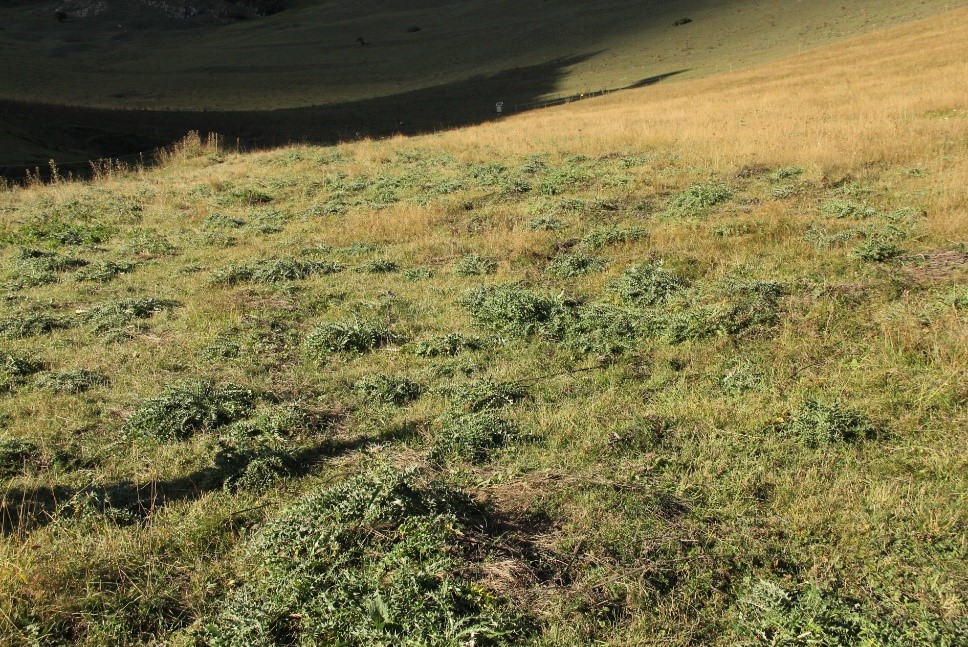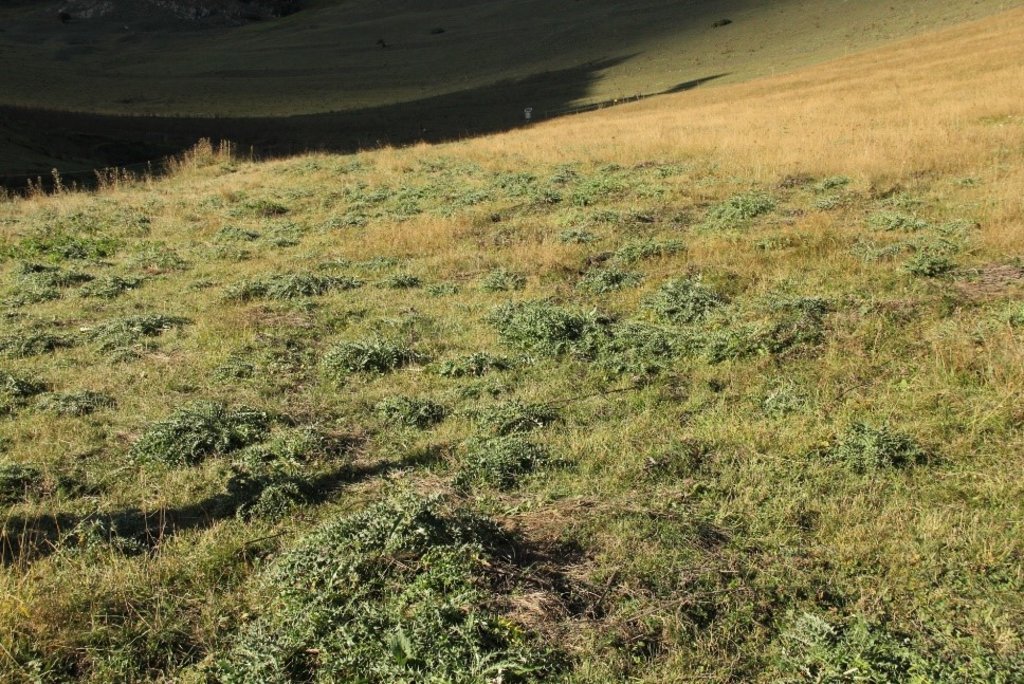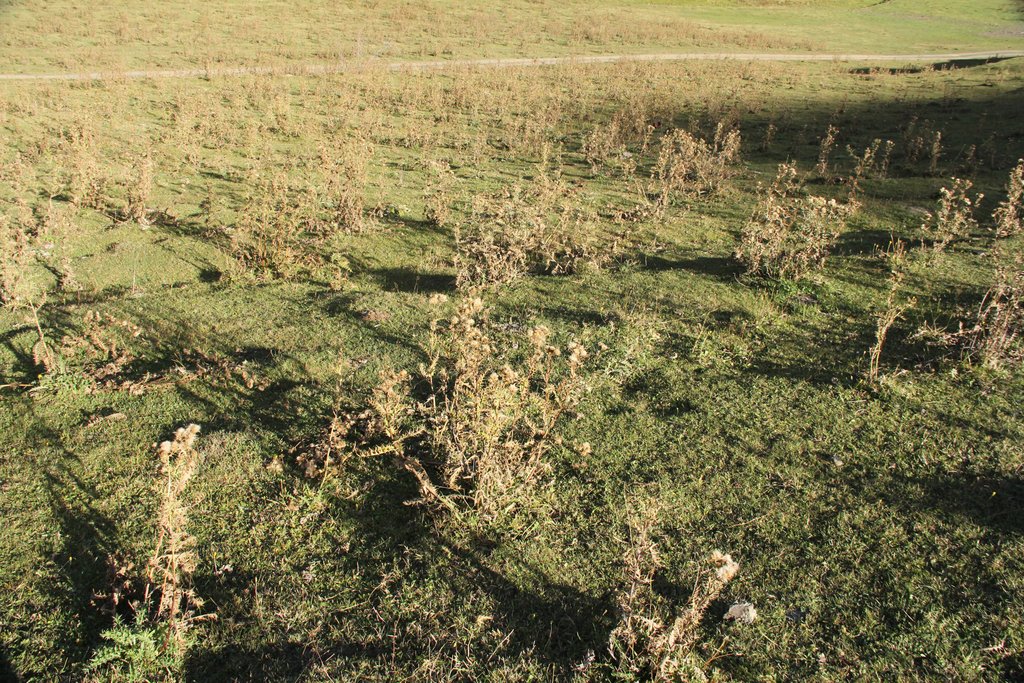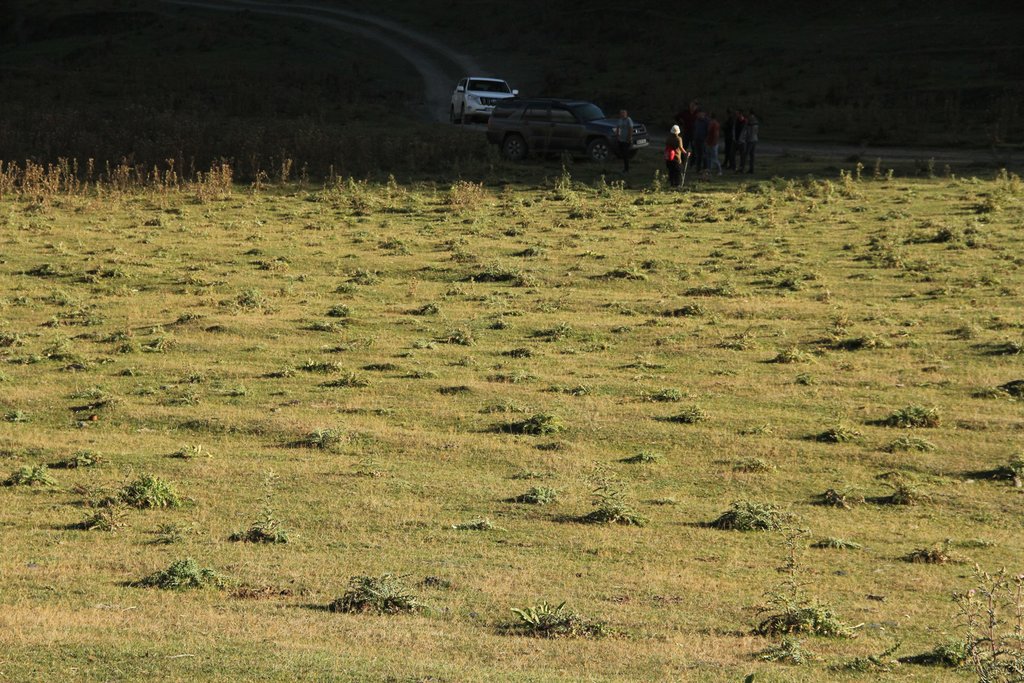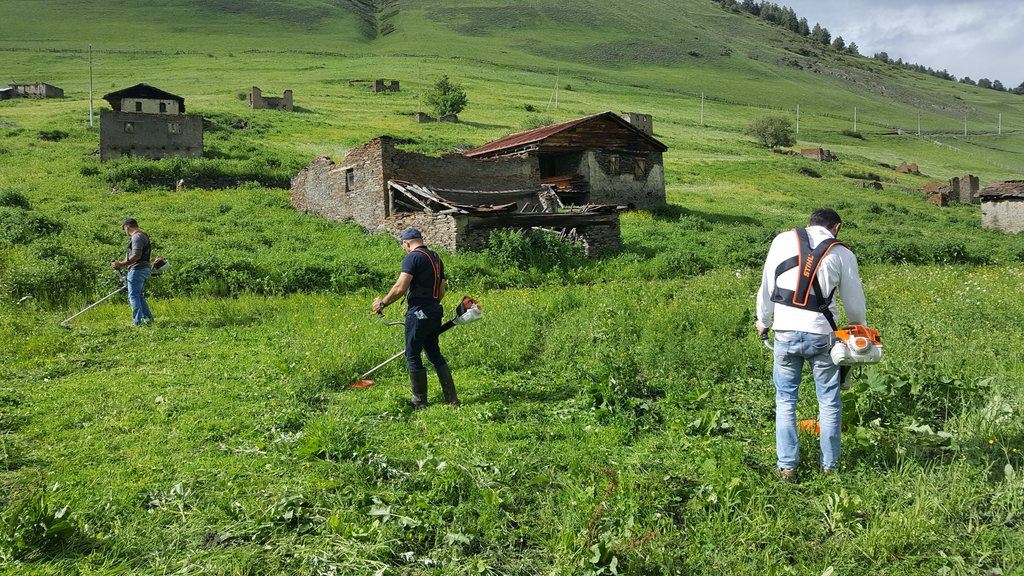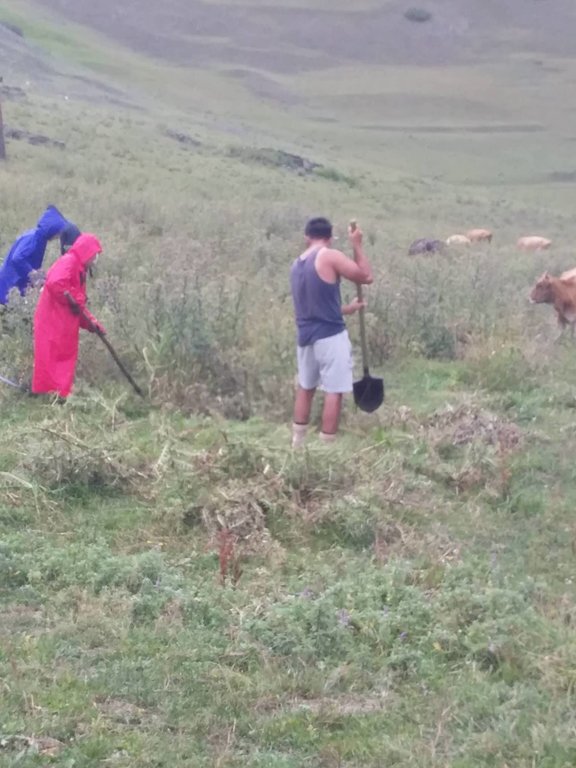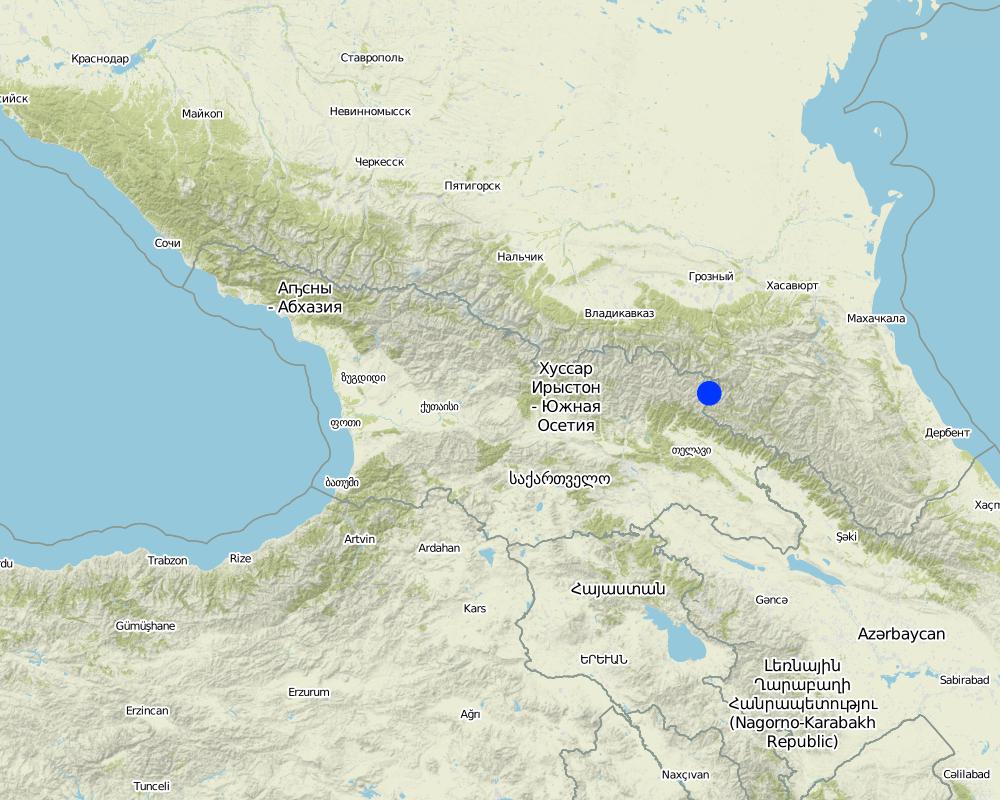Pasture-weed control by thistle cutting [Geórgia]
- Criação:
- Atualização:
- Compilador/a: Hanns Kirchmeir
- Editor: Kety Tsereteli
- Revisor: Ursula Gaemperli
technologies_4273 - Geórgia
Veja as seções
Expandir tudo Recolher tudo1. Informação geral
1.2 Detalhes do contato das pessoas capacitadas e instituições envolvidas na avaliação e documentação da tecnologia
co-compilador/a:
Nome do projeto que facilitou a documentação/avaliação da Tecnologia (se relevante)
Applying Landscape and Sustainable Land Management (L-SLM) for mitigating land degradation and contributing to poverty reduction in rural area (L-SLM Project)Nome da(s) instituição(ões) que facilitou(ram) a documentação/ avaliação da Tecnologia (se relevante)
Regional Environmental Centre for the Caucasus (REC Caucasus) - Geórgia1.3 Condições em relação ao uso da informação documentada através de WOCAT
O/a compilador/a e a(s) pessoa(s) capacitada(s) aceitam as condições relativas ao uso de dados documentados através da WOCAT:
Sim
1.4 Declaração de sustentabilidade da tecnologia descrita
A tecnologia descrita aqui é problemática em relação a degradação da terra de forma que não pode ser declarada uma tecnologia de gestão sustentável de terra?
Não
Comentários:
The applied technology avoids the application of chemicals by mechanical weed removal.
1.5 Referência ao(s) questionário(s) sobre abordagens GST (documentado(s) usando WOCAT)
2. Descrição da tecnologia de GST
2.1 Descrição curta da tecnologia
Definição da tecnologia:
Thistles invaded massively into village pasture land at 1800m elevation in the Caucasus. By cutting the thistles with a motor-cutter the cover of thistles have been reduced.
2.2 Descrição detalhada da tecnologia
Descrição:
The technology was applied in flat sub-alpine pasture land at an elevation of about 1800 m in the village of Shenako in the Tusheti Protected Landscape, Georgia. Precipitation is 750-900mm and mean annual temperature is 2-4°C. Thistles (Cirsium sp.) were invading especially in those sections of the pasture that are rich in nutrients and have medium soil water content. This site conditions can be found mainly at the valley bottom.
There are no big machines available in this mountain villages. So the removal was done by motor-cutters. In this particular case STIHL petrol brush cutters were used with a 3 blade bush knife.
The removal of the thistles, which were covering up to 20% of the pasture land will increase the productivity of valuable fodder grass and herbs. The thistles are growing up to 1m height and taking up significant amount of nutrients from the soil and are shading other grass and herbs in their neighborhood. Because of their spices they are not eaten by cows or sheep, while the grazing pressure is increasing on the remaining grass and herb species. This leads to positive selection of thistles and a permanent increase of the thistles number and biomass in comparison to the high quality fodder plants.
The thistles have been cut in mid-June/beginning of July just at the begin of blossom. At this stage, the thistles mobilized most of the nutrients from their root system and spent them in leaf and blossom biomass. By cutting the thistles at this time, the highest impact on the nutrient balance can be reached and no new seeds will be produced in this year. It was observed, that the thistles have been eaten by the livestock when it was cut and dried up.
The motor brush cutter increases significantly the speed of cutting the thistles compared to hand scythe. The thistle has a powerful root system and is re-sprouting from the roots within the same summer. So it is important to repeat the cutting 2-3 times a year and to continue several years until the amount of thistles is permanently reduced.
The reduction of thistles will give more space, nutrients and moisture to other fodder plants and increase the productivity of the pasture land.
The challenge is the coordination of the work load within the users of the community pasture land. It needs a (written) agreement to share the workload for pasture maintenance between the families according to their number of livestock.
2.3 Fotos da tecnologia
Observações gerais sobre as fotos:
The photos are showing the state of the pastures before and 2 months after the application of the technology.
2.4 Vídeos da tecnologia
Comentários, breve descrição:
No video available
2.5 País/região/locais onde a tecnologia foi aplicada e que estão cobertos nesta avaliação
País:
Geórgia
Região/Estado/Província:
Kakheti
Especificação adicional de localização:
Shenako
Especifique a difusão da tecnologia:
- Uniformemente difundida numa área
Se a Tecnologia estiver uniformemente distribuída por uma área, especifique a área coberta (em km2):
0,02
Se a área precisa não for conhecida, indicar a área aproximada coberta:
- < 0,1 km2 (10 ha)
O(s) local(is) tecnológico(s) está(ão) localizado(s) em uma área permanentemente protegida?
Sim
Caso afirmativo, especifique:
The village of Shenako is located in the Tusheti Protected Landscape. This category is managed by the Municipality of Akhmeta.
Comentários:
The number of families using the village pastureland for their livestock has decreased during the last decades. In former times the 200 ha of open land around the village was used as arable land and hay meadows and the livestock was grazed on remote pastures.
Map
×2.6 Data da implementação
Indique o ano de implementação:
2018
2.7 Introdução da tecnologia
Especifique como a tecnologia foi introduzida:
- através de projetos/intervenções externas
Comentários (tipos de projeto, etc.):
The weed control was funded and applied within a GEF Projected coordinated by REC Caucasus ("Applying Landscape and Sustainable Land Management (L-SLM) for mitigating land degradation and contributing to poverty reduction in rural areas"). It can be assumed, that there have been community based regulation on pasture maintenance before the Soviet period, but this regulations have not been re-established after this period.
3. Classificação da tecnologia de GST
3.1 Principal/principais finalidade(s) da tecnologia
- Melhora a produção
- Reduz, previne, recupera a degradação do solo
- Criar impacto econômico benéfico
3.2 Tipo(s) atualizado(s) de uso da terra onde a tecnologia foi aplicada
Uso do solo misturado dentro da mesma unidade de terra:
Não

Pastagem
Pastagem extensiva:
- Pastoreio transumante
Tipo de animal:
- gado - lácteo
- cavalos
- ovelhas
É praticado o manejo integrado de culturas e pecuária?
Não
Produtos e serviços:
- carne
- leite
Espécie:
gado - lácteo
Contagem:
70
Espécie:
ovelhas
Contagem:
400
Espécie:
cavalos
Contagem:
30
Espécie:
gado - carne bovina não-láctea
Contagem:
35
Comentários:
The area of implementation is community pasture land.
3.3 O uso do solo mudou devido à implementação da Tecnologia?
O uso do solo mudou devido à implementação da Tecnologia?
- Não (Continuar com a pergunta 3.4)
3.4 Abastecimento de água
Abastecimento de água para a terra na qual a tecnologia é aplicada:
- Precipitação natural
3.5 Grupo de GST ao qual pertence a tecnologia
- Gestão de pastoralismo e pastagem
3.6 Medidas de GST contendo a tecnologia

Medidas de gestão
- M5: Controle/mudança de composição de espécies
Comentários:
The technology aims to reduce the amount of thistles in the species composition of the pasture.
3.7 Principais tipos de degradação da terra abordados pela tecnologia

Degradação biológica
- Bs: Qualidade e composição de espécies/declínio de diversidade
Comentários:
The degradation of the pastures is driven by the spreading of thistles. This process leads to a reduction of plant-diversity (shading) and fodder production.
3.8 Redução, prevenção ou recuperação da degradação do solo
Especifique o objetivo da tecnologia em relação a degradação da terra:
- Reduzir a degradação do solo
Comentários:
Cutting thistles is an measure for weed-control and reduces the risk of overgrazing be increasing the available area and amount of fodder plants.
4. Especificações técnicas, implementação de atividades, entradas e custos
4.1 Desenho técnico da tecnologia
Especificações técnicas (relacionada ao desenho técnico):
The activity was applied on two plots. Plot 6 is 0.7 ha of size and located in the unfenced area. Plot 7 is 1.3 ha of size and located inside an electric fence. The hatched area (8) is indicating the fenced area.
Autor:
Hanns Kirchmeir
Data:
20/03/2019
4.2 Informação geral em relação ao cálculo de entradas e custos
Especifique como custos e entradas foram calculados:
- por área de tecnologia
Indique o tamanho e a unidade de área:
2 ha
Especifique a moeda utilizada para os cálculos de custo:
- USD
4.3 Atividades de implantação
| Atividade | Periodicidade (estação do ano) | |
|---|---|---|
| 1. | Prepare machinery and organize people | June |
| 2. | Select pasture plots were the measure will be applied | June |
| 3. | Cut the thistles on the selected pasture plots | End of June - Mid of July |
Comentários:
When working with a hand-held brush cutter it is recommended to start in those areas with less thistles and work into the direction of dense thistle stands. When working with a tractor or a sickle bar mower it is more efficient to apply the activity in dens thistle stands.
4.4 Custos e entradas necessárias para a implantação
| Especifique a entrada | Unidade | Quantidade | Custos por unidade | Custos totais por entrada | % dos custos arcados pelos usuários da terra | |
|---|---|---|---|---|---|---|
| Mão-de-obra | Selection of sites, preparation of materials and people | person-days | 3,0 | 37,0 | 111,0 | |
| Mão-de-obra | Labour for cutting thistles on 2 ha | person-days | 10,0 | 20,0 | 200,0 | |
| Equipamento | High quality brush cutter | pieces | 1,0 | 800,0 | 800,0 | |
| Equipamento | Patrol (20l) and diesel (30l) for brush cutter (6 days, 8h/day, 1l/h) | liter | 50,0 | 1,0 | 50,0 | |
| Custos totais para a implantação da tecnologia | 1161,0 | |||||
| Custos totais para o estabelecimento da Tecnologia em USD | 1161,0 | |||||
Se o usuário da terra arca com menos que 100% dos custos, indique quem cobre os custos remanescentes:
The equipment (brush cutters) and labour costs have been carried by international project (GIZ-IBiS Program, GEF funded SML Project)
4.5 Atividades recorrentes/manutenção
| Atividade | Periodicidade/frequência | |
|---|---|---|
| 1. | Repeat cutting of thistles 2x per year | June/July and September |
4.6 Custos e entradas necessárias pata a manutenção/atividades recorrentes (por ano)
| Especifique a entrada | Unidade | Quantidade | Custos por unidade | Custos totais por entrada | % dos custos arcados pelos usuários da terra | |
|---|---|---|---|---|---|---|
| Mão-de-obra | labour for cutting thistles (2ha) | person-days | 6,0 | 20,0 | 120,0 | 100,0 |
| Equipamento | Patrol for brush cutter | liter | 96,0 | 1,0 | 96,0 | |
| Custos totais para a manutenção da tecnologia | 216,0 | |||||
| Custos totais de manutenção da Tecnologia em USD | 216,0 | |||||
Comentários:
The ongoing maintenance has to be covered by the local farmers
4.7 Fatores mais importantes que afetam os custos
Descreva os fatores mais determinantes que afetam os custos:
The investment in the brush cutter will only pay off if large parts of pastures are managed.
5. Ambiente natural e humano
5.1 Clima
Precipitação pluviométrica anual
- <250 mm
- 251-500 mm
- 501-750 mm
- 751-1.000 mm
- 1.001-1.500 mm
- 1.501-2.000 mm
- 2.001-3.000 mm
- 3.001-4.000 mm
- > 4.000 mm
Especifique a média pluviométrica anual em mm (se conhecida):
850,00
Especificações/comentários sobre a pluviosidade:
Main rainfall in spring and autumn, July and August is the dry season.
Indique o nome da estação meteorológica de referência considerada:
Data from CHELSA.ORG
Zona agroclimática
- Subúmido
Because of low annual temperature (2-4°C) the evapotranspiration is low and most of the year there is no water shortage. But in August and September drought can occur.
5.2 Topografia
Declividade média:
- Plano (0-2%)
- Suave ondulado (3-5%)
- Ondulado (6-10%)
- Moderadamente ondulado (11-15%)
- Forte ondulado (16-30%)
- Montanhoso (31-60%)
- Escarpado (>60%)
Formas de relevo:
- Planalto/planície
- Cumes
- Encosta de serra
- Encosta de morro
- Sopés
- Fundos de vale
Zona de altitude:
- 0-100 m s.n.m.
- 101-500 m s.n.m.
- 501-1.000 m s.n.m.
- 1.001-1.500 m s.n.m.
- 1.501-2.000 m s.n.m.
- 2.001-2.500 m s.n.m.
- 2.501-3.000 m s.n.m.
- 3.001-4.000 m s.n.m.
- > 4.000 m s.n.m.
Indique se a tecnologia é aplicada especificamente em:
- Posições côncavas
Comentários e outras especificações sobre a topografia:
The most dense thistle populations are observed on the flat valley floors and concave depressions at the slopes where the soil is rich in nutrients and has well balanced soil moisture.
5.3 Solos
Profundidade do solo em média:
- Muito raso (0-20 cm)
- Raso (21-50 cm)
- Moderadamente profundo (51-80 cm)
- Profundo (81-120 cm)
- Muito profundo (>120 cm)
Textura do solo (solo superficial):
- Médio (limoso, siltoso)
- Fino/pesado (argila)
Textura do solo (>20 cm abaixo da superfície):
- Médio (limoso, siltoso)
- Fino/pesado (argila)
Matéria orgânica do solo superficial:
- Médio (1-3%)
Caso disponível anexe a descrição completa do solo ou especifique as informações disponíveis, p. ex. tipo de solo, PH/acidez do solo, nitrogênio, capacidade de troca catiônica, salinidade, etc.
Detailed soil data not available.
5.4 Disponibilidade e qualidade de água
Lençol freático:
< 5 m
Disponibilidade de água de superfície:
Bom
Qualidade da água (não tratada):
Água potável precária (tratamento necessário)
A qualidade da água refere-se a:
tanto de águas subterrâneas quanto de superfície
A salinidade da água é um problema?
Não
Ocorre inundação da área?
Não
Comentários e outras especificações sobre a qualidade e a quantidade da água:
Only in years with low precipitation there is water shortage in August and September.
5.5 Biodiversidade
Diversidade de espécies:
- Médio
Diversidade de habitat:
- Baixo
Comentários e outras especificações sobre biodiversidade:
The high grazing pressure leads to medium plant species diversity.
5.6 Características dos usuários da terra que utilizam a tecnologia
Sedentário ou nômade:
- Semi-nômade
Orientação de mercado do sistema de produção:
- Subsistência (autoabastecimento)
Rendimento não agrícola:
- Menos de 10% de toda renda
Nível relativo de riqueza:
- Média
Indivíduos ou grupos:
- Indivíduo/unidade familiar
- Grupos/comunidade
Nível de mecanização:
- Trabalho manual
- Mecanizado/motorizado
Gênero:
- Mulheres
- Homens
Indique outras características relevantes dos usuários da terra:
The village is only occupied during summer time (June-September). One of the farmers stays in the village during winter time.
5.7 Área média de terrenos utilizados pelos usuários de terrenos que aplicam a Tecnologia
- < 0,5 ha
- 0,5-1 ha
- 1-2 ha
- 2-5 ha
- 5-15 ha
- 15-50 ha
- 50-100 ha
- 100-500 ha
- 500-1.000 ha
- 1.000-10.000 ha
- > 10.000 ha
É considerado pequena, média ou grande escala (referente ao contexto local)?
- Média escala
Comentários:
The community pasture land is around 200 ha. This area is shared by 4-6 households with livestock (sheep, cattle). Some view more families bring some horses up to Shenako during summer months.
5.8 Propriedade de terra, direitos de uso da terra e de uso da água
Propriedade da terra:
- Comunitário/rural
Direitos do uso da terra:
- Acesso livre (não organizado)
Direitos do uso da água:
- Acesso livre (não organizado)
Os direitos de uso da terra são baseados em um sistema jurídico tradicional?
Não
Comentários:
The pasture land is in municipal land and managed by the community.
5.9 Acesso a serviços e infraestrutura
Saúde:
- Pobre
- Moderado
- Bom
Educação:
- Pobre
- Moderado
- Bom
Assistência técnica:
- Pobre
- Moderado
- Bom
Emprego (p. ex. não agrícola):
- Pobre
- Moderado
- Bom
Mercados:
- Pobre
- Moderado
- Bom
Energia:
- Pobre
- Moderado
- Bom
Vias e transporte:
- Pobre
- Moderado
- Bom
Água potável e saneamento:
- Pobre
- Moderado
- Bom
Serviços financeiros:
- Pobre
- Moderado
- Bom
Comentários:
Most important of-farm income is tourism (guesthouses, crafts).
6. Impactos e declarações finais
6.1 Impactos no local mostrados pela tecnologia
Impactos socioeconômicos
Produção
Produção de forragens
Comentários/especificar:
By reduction of thistles the space for other plant species has increased.
Especificar a avaliação dos impactos no local (medidas):
The impact of the weed control on the productivity will increase when the vitality of thistles will be further reduced by frequently repetition of cutting.
6.2 Impactos externos mostrados pela tecnologia
Especificar a avaliação dos impactos fora do local (medidas):
The dissemination of thistles seeds in the surrounding areas is reduced, when thistles are cut before blossom.
6.3 Exposição e sensibilidade da tecnologia às mudanças climáticas graduais e extremos/desastres relacionados ao clima (conforme o ponto de vista dos usuários da terra)
Comentários:
These sites at the valley bottom have high soil moisture content and did not show significant impact of climate change in the last decade.
6.4 Análise do custo-benefício
Como os benefícios se comparam aos custos de implantação (do ponto de vista dos usuários da terra)?
Retornos a curto prazo:
levemente negativo
Retornos a longo prazo:
positivo
Como os benefícios se comparam aos custos recorrentes/de manutenção(do ponto de vista dos usuários da terra)?
Retornos a curto prazo:
neutro/balanceado
Comentários:
The productivity of the pastureland is 2-3t/ha per year. The removal of thistles can lead on the long term to an increase of fodder by 20% (400-600kg/ha per year). This is equivalent to 15-20 hay-bales a 3 USD (total 45-60 USD/ha and year). The amount of time for cutting the thistles and the needed patrol will decrease when during the next years so a positive balance between investment and return is expected.
6.5 Adoção da tecnologia
- casos isolados/experimental
De todos aqueles que adotaram a Tecnologia, quantos o fizeram espontaneamente, ou seja, sem receber nenhum incentivo/ pagamento material?
- 0-10%
Comentários:
It will take 2-3 years to show the full success of the measure. It needs a to negotiate new regulations on village level to agree on how to share the workload for pasture maintenance between the households according to the number of cattle.
6.6 Adaptação
A tecnologia foi recentemente modificada para adaptar-se as condições variáveis?
Não
6.7 Pontos fortes/vantagens/oportunidades da tecnologia
| Pontos fortes/vantagens/oportunidades na visão do usuário da terra |
|---|
| Decreasing the cost for maintanace of cattle |
| Reducing the working hours |
| Improving the pastures via weed control |
| Pontos fortes/vantagens/oportunidades na visão do/a compilador/a ou de outra pessoa capacitada |
|---|
| Easy to apply, no specific skills needed |
| Visible impact within a few years |
6.8 Pontos fracos, desvantagens/riscos da tecnologia e formas de superá-los
| Pontos fracos/desvantagens/riscos na visão do usuário da terra | Como eles podem ser superados? |
|---|---|
| Irresponsibility of some members of the community during the maintenance of el-fence |
| Pontos fracos/vantagens/riscos na visão do/a compilador/a ou de outra pessoa capacitada | Como eles podem ser superados? |
|---|---|
| No responsibility within the community pasture land for maintenance of pasture land. | A new regulation on how to share the workload of pasture maintenance could be negotiated between villagers. |
| Machinery is expensive. | The investment will pay off when the measures are applied to the entire pasture land (100-200 ha). |
7. Referências e links
7.1 Métodos/fontes de informação
- visitas de campo, pesquisas de campo
2 times. On before and on after implementation
- entrevistas com especialistas em GST
1 (the national field expert)
- compilação de relatórios e outra documentação existente
Project report from SLM expert
Quando os dados foram compilados (no campo)?
12/09/2018
7.4 Comentários gerais
REC Caucasus was implementing the project in close cooperation with the Protected Landscape Administration at the Municipality.
A cost-benefit analysis is planned to be prepared in the next phase
Links e módulos
Expandir tudo Recolher tudoLinks
Não há links
Módulos
Não há módulos


